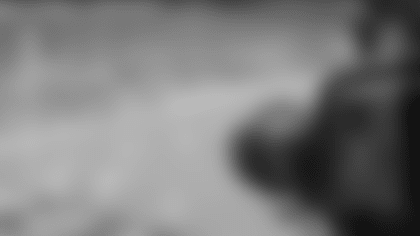When Ezekiel Ansah arrived at BYU from Ghana in 2008, very few people knew who he was. A few short years later, he's become one of the most buzzed-about players in the 2013 NFL Draft class. The pass-rushing prospect will be carefully studied, his potential measured and pored over by interested teams -- and fans -- for the next three months.
Given all the ink and air time that will be spent covering the most popular offseason event in pro football, people will get to know more about this guy than they know about some of their own family members. And that makes him a perfect example of how the draft has changed in the past 50 years. Because if it weren't for all that attention, I don't know if Ansah -- who didn't start playing for the BYU football team until 2010 -- would even be on anybody's radar right now, let alone a likely first-round pick.
In the 1950s and '60s, the draft hardly resembled what it is today. There was no NFL Scouting Combine; there weren't all these pro days and workouts. Teams didn't wait until April; the draft was held more or less right after the previous regular season had ended (so the 1964 draft, for example, actually took place in 1963). It also wasn't held in Radio City Music Hall; teams used to gather for the event in hotel ballrooms, setting up next to each other at banquet tables.
As someone who participated in several of those drafts while working for NFL teams, I can say the whole thing used to be kind of a bare-bones operation compared to what we have now. But it sure was a lot of fun. I thought I'd share some of my favorite memories from those days, to show just how much this event has changed since then.
You've got to be joking
With the exception of the Los Angeles Rams and San Francisco 49ers, most teams would come into the draft with football magazines or newspapers, like the Billings Gazette, which would, for example, have college all-star teams listed in them. The other thing most teams would bring was a whole roll of quarters. When someone needed, say, a tackle, they might go out to the lobby, pick up a payphone, call a school and say, "Hey, we need a tackle; you got anybody good?"
Here's an example of how loose everything used to be. Teams used to get film of prospects from the colleges they played for and against. The Rams, who were at the forefront of new techniques and tactics, were preparing for the 1956 draft when someone at the team suggested, kind of as a joke, that they get more film of this prospect named Dick Donlin from Hamline University in St. Paul, Minn. He was a basketball player, a track athlete and a football player, though he wasn't especially good. But the Rams called the schools around Hamline and got more film of Donlin.
Eventually, it was time for the draft, which I got to attend because I was working with the Rams on a part-time basis. In the second round, the Baltimore Colts used the 21st overall pick to select ... none other than Dick Donlin. In fact, not only did they draft him, they came over to our table and bragged to us about it.
It turned out that someone from one of those schools up in Minnesota called the Colts and said, "Hey, the Rams are really hot on this guy." Apparently, this was enough to prompt Baltimore to pick him. In the end, Donlin was cut before he ever played a snap.
Time was on our side
Teams that draft today have just a few minutes with which to make their picks, but the clock didn't used to tick so intensely. In fact, during the 1964 draft, when I was working with the Dallas Cowboys, I remember that we held everything up for five hours before we made our second-round pick.
We were thinking about drafting Mel Renfro, a running back out of Oregon. The thing was, the draft was being held on Dec. 2, 1963 -- shortly after President Kennedy had been killed. The assassination had so upset Renfro that he'd put his hand through a mirror. We knew he'd done that, but we didn't know how serious the injury was, so we called a doctor in Portland to drive the 100 miles or so to Eugene and give Renfro a look. The whole process took about five hours, and we waited it out.
While we were waiting, Vince Lombardi walked over to our table, laughed sarcastically and asked us if our computer had broken down. Eventually, we did draft Renfro -- we switched him to defensive back and he went on to grab 52 interceptions over a 14-year career before making it into the Pro Football Hall of Fame. I'd say the wait was worth it.
A true talent competition
In the days before the AFL and NFL merged, the two leagues battled each other for talent, holding competing drafts and, essentially, attempting to recruit players away from the other league.
I was involved in one such recruiting battle during the 1962 draft when I worked for the Cowboys. A guy named Amos Bullocks, a prospect out of Southern Illinois, had been selected in the 10th round of the AFL draft by the Buffalo Bills. We knew that, but we liked him, so I called his mom to see if he'd signed. She said he wanted to play for the Cowboys and hadn't signed with anyone yet, so we went ahead and drafted him. After the draft was over, I got on a private plane and went to Carbondale, Ill., where he was.
When I walked into the building to meet Bullocks, I saw that he was sitting in an office with Bills head coach Lou Saban. The door was open, so I waved my hand at Bullocks to come with me. He got up, walked out, and came with me. I took him to a local clothing store, bought him a suit and some shoes and signed him. Then I brought him back to the office. When Saban asked him where he'd been, he said, "I just went out and signed with the Cowboys." So I said, "Thanks, guys," and got out of there.
Third time's the charm
Plenty of prospects nowadays would give anything to be selected with a draft pick. Donnie Caraway experienced the sensation three times in three years.
In 1956, the Washington Redskins picked him in the seventh round. In 1957, the Chicago Bears nabbed him in the 29th round. In 1958, he shot back up to the fourth round, where he was selected by the New York Giants.
That shows how chaotic the draft could be. There's no chance something like that could happen today, not with all of those television broadcasts and websites that'll tell you the minute a guy is drafted.
Back then, though, it was nothing like that. One draft I remember was covered by a handful of national writers and no one else -- no local newspapers, no one from radio. The only way to find out who was drafted was to scan the tiny "transactions" column in the sports page of the paper.
Room for change
There's always talk about having quarterbacks -- like Michigan's Denard Robinson -- change positions, and there's a long tradition of that happening. I can think of two college quarterbacks the Cowboys drafted while I was there who switched to another position and wound up doing well in the pros.
In 1965, we took Brig Owens, a quarterback out of Cincinnati, in the seventh round, and moved him to safety. He didn't end up making our team, but he did land with the Redskins at his new position and played 158 games there, racking up 36 interceptions. In the 12th round of that same draft, we grabbed a quarterback out of Miami of Ohio named Ernie Kellerman. I had to promise his college coach, Bo Schembechler, that we'd try him out at quarterback, but he was just so short and didn't have a strong arm. He was, however, a good athlete and ended up at corner. Again, he didn't make our team, but he put together a pretty nice 105-game stint with the Cleveland Browns.






































